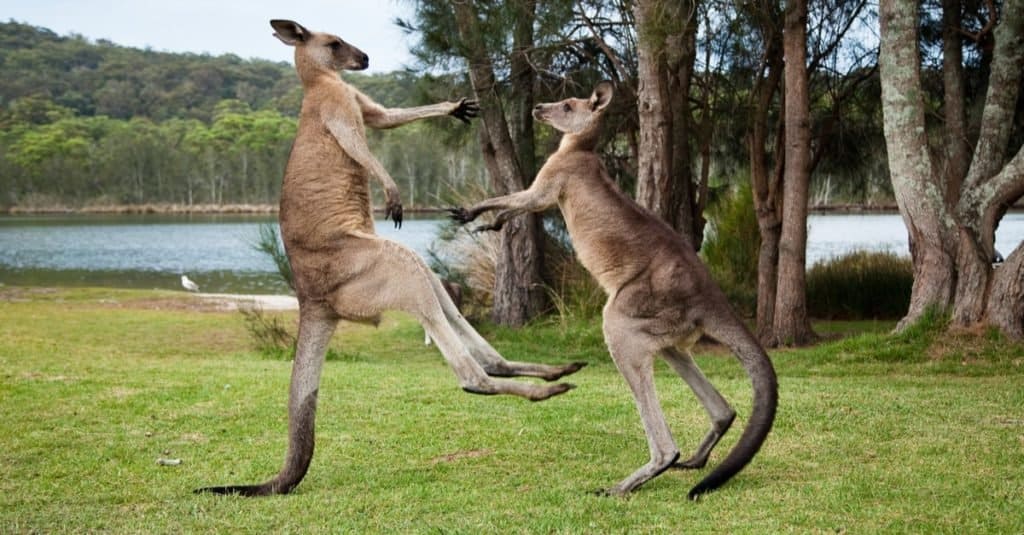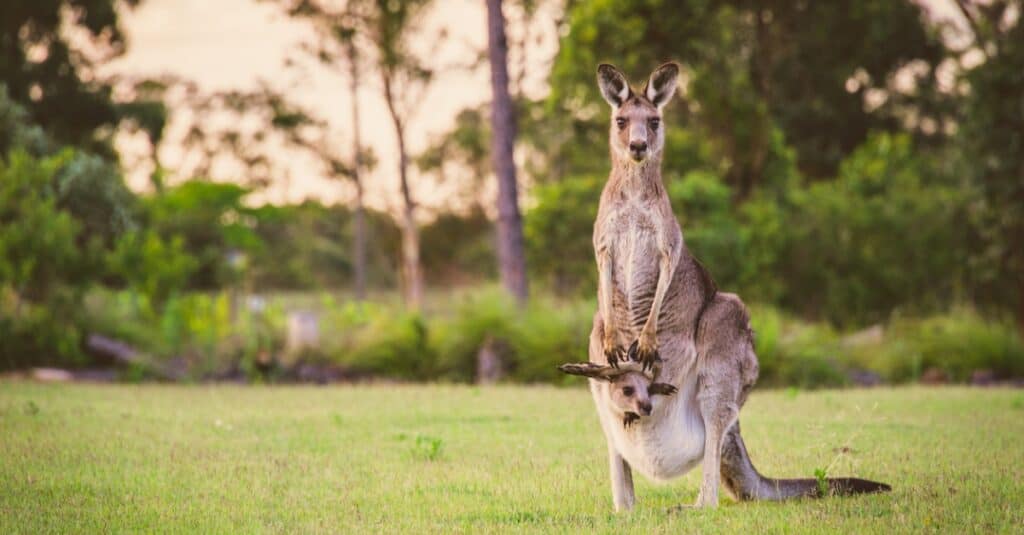Kangaroos are an incredible species of mammal living in the Oceania region. They live in forests, woodlands, and plains, and their main predators are humans and dingos. These herbivores have some incredibly unique characteristics, including long jumps and pouches for carrying their young.
There are quite a few different breeds of kangaroos, but the species as a whole offers a lot of similarities. In general, kangaroos have strong legs and long tails, and they prefer to live in a community with one another. Herds of kangaroos are actually called mobs. The IUCN has rated kangaroos as “Least Threatened,” meaning kangaroos are not in near danger of extinction.
These quick animals have some pretty impressive stats. Kangaroos can reach up to 35 miles per hour due to their incredible feet and hind legs! Their large feet also enable them to jump extraordinary lengths in one go. A kangaroo can generally jump up to 20 feet in one single hop, though some incredible kangaroo athletes have reached 30 feet! To fully understand the kangaroo, it’s helpful to break down the differences between sexes.
Male and female kangaroos have a long list of differences. These differences allow groups of kangaroos to fill various roles in the community. Males are equipped with different strengths than females, but both work together to create a cohesive group of kangaroos. They’re a sociable species, so understanding the way each sex of kangaroo works together is an integral part of understanding kangaroos as a whole.
Male and female kangaroos have a few key differences. These include size, social behavior, build, pouch presence, parental role, and, of course, nicknames. Each sex of the kangaroo plays a vital role in their community, and the differences between the sexes work to aid the kangaroo’s specific position. Their differences are what makes their community strong!
| Trait | Male Kangaroos | Female Kangaroos |
|---|---|---|
| Nicknames | Buck, boomer, old man, or jack | Doe, flyer, roo, or jill |
| Size | Taller & heavier | Significantly shorter & lighter |
| Social Behavior | Bachelor groups | Maternal groups |
| Pouch | Has no pouch | Has pouch for childcare |
| Build | Strong, muscular forearm muscles | Less muscular forearm muscles |
| Parental Role | Protect & defend | Pouch care & nurturing |
Male vs Female Kangaroos: Nicknames
One difference between male and female kangaroos is nicknames. When you’re reading up on kangaroos, you’ll hear the different sexes of kangaroos referred to by a lot of different names. Male kangaroos are generally called bucks, boomers, old men, or jacks. Females, on the other hand, are called does, flyers, roos, or jills. It’s important to understand the various nicknames of kangaroos since they identify gender! Be careful not to confuse kangaroo bucks and does with deer, however. The two species are not closely related at all.
Male vs Female Kangaroos: Size

Male kangaroos will kick during fights.
©Breathes/Shutterstock.com
Another key difference between male and female kangaroos is size. Male kangaroos can sometimes be up to two times larger than female kangaroos! The specific measurements of kangaroos vary a lot from species to species. The largest Australian marsupial is the red kangaroo. Male red kangaroos are about 5’10” and almost 200 pounds. Females are significantly shorter and a fraction of the weight. They are generally closer to 60 pounds. Kangaroo height is measured to include the tail, however. So male red kangaroos are about four feet tall excluding the tail, which adds another two feet.
The difference in size between the sexes makes sense given the social roles of each sex of kangaroo. Their size equips them for the roles they have within their mob. Adaptive traits, like size, serve to aid in the kangaroo’s survival ability. So while it seems disadvantageous to a female kangaroo to be smaller, their size isn’t very relevant to their role in the mob. Long story short, they don’t need to be nearly as giant as the men.
Male vs Female Kangaroos: Social Behavior
One of the key differences between male and female kangaroos is their social behavior. Mobs have very specific roles that are generally sorted by sex. Male kangaroos hang out in bachelor groups, while female kangaroos hang out with other mothers. These distinctions in the subgroups that they hang out with aren’t purely social. These subgroups have key roles in the community.
Male Social Behavior
Male kangaroos exist primarily in a group with other male kangaroos. These are called bachelor groups. Within the bachelor group, a hierarchy is created that allows the dominant kangaroos a higher spot in the ranks. The most dominant kangaroos are referred to as boomers, and they have their first choice when it comes to eating and mating. In order to climb the hierarchy, lower-ranked bucks need to fight their way to the top.
While the hierarchy of male kangaroos seems cutthroat, it serves an important purpose. In the whole mob, the male kangaroos are the ones that provide the territory defense. They protect the area where the mob lives and ensure that resources are protected, as well. Thus, a strong hierarchy is necessary to ensure effective protection and defense.
Female Social Behavior
Female kangaroos, on the other hand, live in maternal groups. These groups can be small or can include quite a few different females and their offspring. Joeys, which are young kangaroos, are born very vulnerable, so a lot of attention is necessary to ensure that they safely develop. Maternal groups are collaborative but also feature a hierarchy. Older, more experienced female kangaroos take the dominant role. This role, however, is more focused on leadership. Dominant females will lead the group through foraging. They do have some perks, however, like first access to resources.
Female kangaroos are responsible for group cohesion. They keep the mob connected and organized. Their role is to rear the young kangaroos to be successful and healthy once out of the pouch.
Male vs Female Kangaroos: Pouch

When joeys are newly born, they are about the size of a grape!
©iStock.com/Andrew Coleman
A clear difference between female and male kangaroos is the presence of the pouch. The pouch is one of the most recognizable features of kangaroos. The pouch, scientifically called the marsupium, is where joeys (young kangaroos) live after birth. Newborns stay protected in the pouch after birth for around eight months. They nurse from their mothers, so it makes sense that the pouch is with them.
Male kangaroos do not have a pouch. They are much less involved in the rearing of young kangaroos and, therefore, it is the female kangaroo’s body that carries the young in the pouch. When considering the roles of the sexes of kangaroos, it makes sense that the joeys remain protected in a female’s pouch. Male kangaroos sometimes have to spar in a way that would put their young at risk if they had pouches.
Male vs Female Kangaroos: Build
Related to size, male and female kangaroos feature a very different build. Male kangaroos fight regularly, while female kangaroos are much more focused on rearing their young. Because of this, male kangaroos are generally more stocky than females. They also have developed forearm muscles, whereas females generally lack that muscular build. Again, their role in the community informs their physical size and structure. The collaborative females need a lot less muscle than the aggressive males.
Male vs Female Kangaroos: Parental Role

Australia can be a treacherous environment, so the defense offered by both female and male kangaroos is vital to the success of the offspring.
©Nick Fox/Shutterstock.com
Related to their social behavior, the sexes of kangaroos have incredibly different jobs when it comes to parenting. Female kangaroos take the primary role, carrying the joey in their pouch and providing nursing. Once the joey is a bit older, the females teach the joey to spar and continue to offer grooming and nurturing. Females are the primary teachers when it comes to foraging for food, as well.
Male kangaroos are less involved in the parenting process due to their lack of pouch. Because they neither carry nor feed the joey, the early months of parenting are primarily left to the female. However, the males are the protectors of the mob and therefore play an important role in ensuring the safety of the joey.
The photo featured at the top of this post is © iStock.com/JohnCarnemolla
Thank you for reading! Have some feedback for us? Contact the AZ Animals editorial team.







